Naganohara Town, Gunma Prefecture
Edo period (5 August 1783)
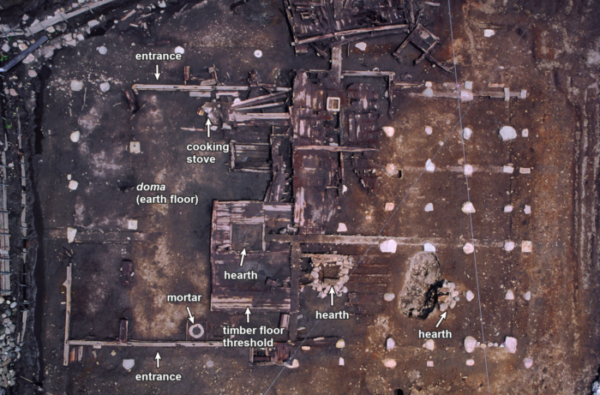
Conditions of discovery at Building No. 1 (north at the photo’s top) Not swept away by the Tenmei Mudflow, floor boards, hearths, and so forth remained. On the eastern side (to the right in the photo) there are only pillar base stones as the floorboards did not survive, but the western side (at the photo’s left) was spared from decay, perhaps because of a nearby source of spring water, and floorboards were recovered along with various implements in great numbers. Adapted from Hakkutsu sareta Nihon rettō 2019 [Excavations in the Japanese Archipelago, 2019] (Bunkachō [Agency for Cultural Affairs], ed., Kyodo News, 2019).

Distant view of the Higashimiya site (from the southwest) The Agatsuma River is to the right in the photo.
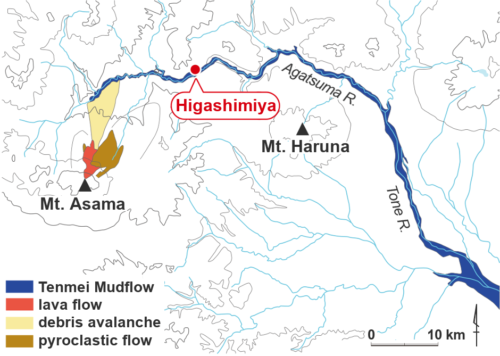
Site location map Approximately 23 km northeast from Mt. Asama, on the northern bank of the Agatsuma River. On 5 August 1783 the Tenmei Mudflow arose and coursed down the Agatsuma and Tone rivers, bringing enormous damage to villages of the region. Adapted from Hakkutsu sareta Nihon rettō 2019 [Excavations in the Japanese Archipelago, 2019] (Bunkachō [Agency for Cultural Affairs], ed., Kyodo News, 2019).

Timber floor (Building No. 1; threshold at the photo’s front) Wooden clogs, straw sandals, and various implements pushed in by the mudflow were found buried beneath this section of timber floor, built jutting out over the doma (packed earth floor).

Mortar (Building No. 1) Found in the doma (packed earth floor) near the entrance to Building No. 1. Inside were a square measuring box, whisk broom, and so forth, and it is thought to have been fitted with a wooden cover found nearby.
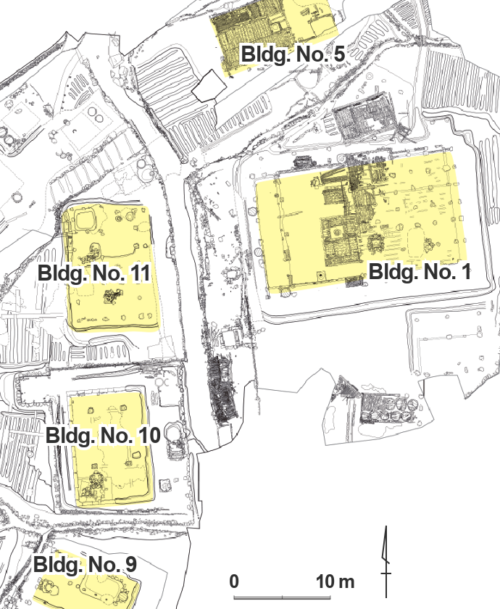
Plan of the Higashimiya site (portion) Buildings lined up on opposite sides of a road running north–south, with fields spreading out over a broad area in the environs. Building No. 10 was a sake brewery, while Nos. 1, 5, and others were main residences. Adapted from Hakkutsu sareta Nihon rettō 2019 [Excavations in the Japanese Archipelago, 2019] (Bunkachō [Agency for Cultural Affairs], ed., Kyodo News, 2019).
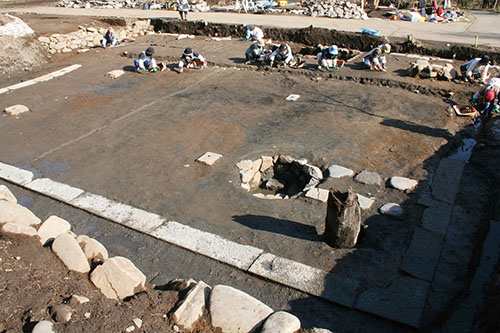
Conditions of discovery at Building No. 10 Wooden troughs, barrels, lipped bowls and so forth, implements for making sake, were recovered. This is thought to have been a brewery. The pillar and stone arrangement in the foreground to the right are the remains of a “pressing site.” Here cloth bags filled with moromi (fermented mash) were placed into a sakabune (pressing tub) and the liquid squeezed out.

Wooden plugs, in situ (Building No. 10) There were 73 items found in a group. It is possible they had been placed in a cloth bag.
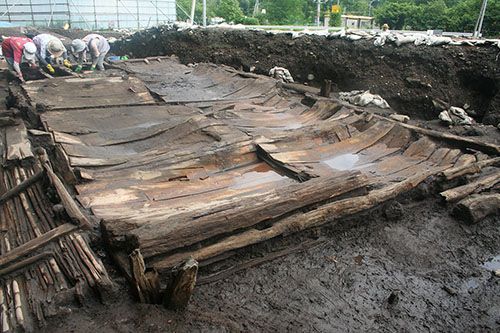
Conditions of discovery at Building No. 5 This was a main residence where the floorboards were well preserved. At the rear in the photo is the deposit from the Tenmei Mudflow. Beneath that layer the floorboards of the building and various implements lay buried in nearly their original locations.
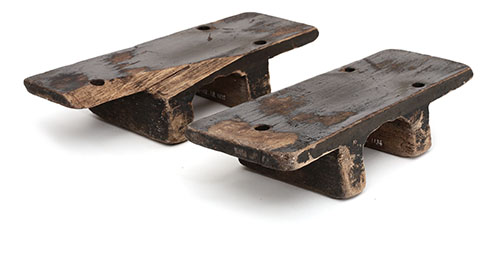
Wooden clogs Numerous items were recovered in different shapes and sizes. Length: 22.6 cm; width: 9.1–9.4 cm; height: 4.6–5.1 cm.
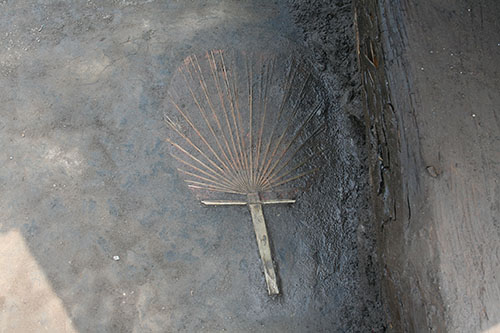
Fan A horizontal bamboo piece is attached at the top of the handle for increased strength. Each rib of the fan was split midway to extend outward in two branches, improving flexibility and enhancing air propulsion. Length: 37.7 cm; width: 24.2 cm; thickness: 0.2 cm.
A village buried by the Tenmei Mudflow caused by a Mt. Asama eruption
The Tenmei Mudflow that struck the village
The Higashimiya site is in the northwestern portion of Gunma Prefecture, in the town of Naganohara in Agatsuma District, at a height of approximately 30–50 m above the present-day riverbed of the Agatsuma River. It falls within the area scheduled for inundation by the Yanba Dam, and when excavation was conducted in conjunction with the dam construction, a village buried by the Tenmei Mudflow was discovered.
The Tenmei Mudflow was triggered by a massive eruption of Mt. Asama, which sits some 23 km southwest of the Higashimiya site, on 5 August 1783 (eighth day, seventh month, third year of the Tenmei era by the Japanese calendar in use at the time). The avalanche of earth and rocks that occurred on the northern slope flowed into the Agatsuma River, becoming a huge mudflow which buried villages in its path as it coursed down the Agatsuma and Tone rivers, wreaking enormous damage. It is inferred that the lives of about 1,500 persons were lost to the debris avalanche and ensuing Tenmei Mudflow.
Higashimiya was one of the hamlets damaged by the mudflow, a portion of the larger village of Kawarahata at the time. Thus the Tenmei Mudflow struck even Kawarahata Village, located at a relatively high position from the riverbed.
Recovered articles convey the breath of daily life and urgent conditions
In the excavation, from under the Tenmei Mudflow deposit roughly 1 m thick, the buildings and fields, wells and roads of the time were ascertained. In a number of buildings the floorboards and hearths were discovered in their exact positions at the time, and many implements such as iron kettles and lanterns were recovered. It can be seen that daily life was carried out in the village until just before the time of disaster.
Also, numerous wooden clogs and straw sandals were found in Building No. 1, but there were no discoveries of people who failed to flee. Among the residents who could have scarcely imagined such an assault on their village as the Tenmei Mudflow, we thus glimpse an image of some escaping barefoot while running in panic from the torrent bearing down right before their eyes.
There are tales in this region of persons who “fled once, but returned to retrieve the ancestral tablets from their homes, and while thus engaged were swept away to their deaths,” or others who “fled after saddling their prized sake [rice wine] to their horses.” Such conditions of the moment relayed orally in this manner are preserved as well at this site.
Ordinarily, if buried more than 200 years in the ground, building materials and household implements will decay and be lost. But if the mudflow had hit with more violent force, those many implements would have been be swept away with the buildings themselves. A number of conditions thus came together at the Higashimiya site to allow both everyday and urgent conditions to come to light. (Kurosawa Teruhiro)

